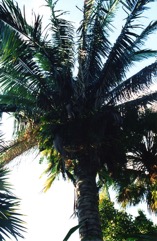Cohune Nut

A tropical plant. It does best in the hot humid lowland tropics. It grows at low elevations in Central America. It suits hardiness zones 9-12. It needs regular moisture and humidity. It needs fertile, well drained soil. It needs full sun. In Cairns Botanical Gardens. In Townsville palmetum.
Also known as:
Biscoyol, Cayaco, Coquito, Coquito de aceite, Corozo, Coyol, Guacoyol, Manaca, Palem kohune
Synonyms
- Cocos cocoyule Mart.
- Cocos guacuyule Liebm ex Mart.
- Orbignya cohune (Mart.) Dahlgren ex Standl.
- Orbignya dammeriana Barb. Rodr.
- Orbignya guacuyale (Liebm. ex Mart.) E. Hern.
Edible Portion
- Cabbage, Kernel, Oil, Fruit, Palm heart, Nuts, Vegetable
Where does Cohune Nut grow?
Found in: Asia, Australia, Belize, Central America, Colombia, Costa Rica, El Salvador, Guatemala, Honduras, Indonesia, Malaysia, Mexico, Nicaragua, North America, SE Asia, Singapore, South America, United States
Notes: There are between (22) 30-71 Attalea species. Some authorities divide them among Attalea, Orbignya, Scheela and Maximiliana. Cohune oil is used as a lubricant.
Growing Cohune Nut
Cultivation: Plants are grown from seed. Seed germinate readily. They take 2 months to germinate. Young plants can withstand direct sun.
Edible Uses: The young leaf buds are cooked and eaten as a vegetable. The nuts yield an oil which can substitute for coconut oil. The kernels are removed from the shell. The oil is used in margarine and for baking and in biscuits.
Production: Nuts are often collected after they fall. The nut has a hard shell. There is a machine capable of breaking 100 tons of fruit per day. The palm heart is usually taken from a 7-10 year old palm. One palm can yield 250 kg of nuts per year.
Nutrition Info
per 100g edible portion| Edible Part | Energy (kcal) | Protein (g) | Iron (mg) | Vitamin A (ug) | Vitamin c (mg) | Zinc (mg) | % Water |
|---|---|---|---|---|---|---|---|
| Palm heart | - | - | - | - | - | - | |
| Nuts | - | - | - | - | - | - | |
| Nut | - | 6.8 | - | - | - | - |
Cohune Nut Photos

References
Altschul, S.V.R., 1973, Drugs and Foods from Little-known Plants. Notes in Harvard University Herbaria. Harvard Univ. Press. Massachusetts. no. 92
Balick, M.J. and Beck, H.T., (Ed.), 1990, Useful palms of the World. A Synoptic Bibliography. Colombia p 59 (As Orbignya cohune), 122, 310, 470 (As Orbignya guacuyule), 604,
Bircher, A. G. & Bircher, W. H., 2000, Encyclopedia of Fruit Trees and Edible Flowering Plants in Egypt and the Subtropics. AUC Press. p 48
Blomberry, A. & Rodd, T., 1982, Palms. An informative practical guide. Angus & Robertson. p 135 (As Orbignya cohune)
Bost, J. B., 2009, Edible plants of the Chinantla, Oazaca, Mexico. Master's thesis University of Florida. p 39
Burkill, I.H., 1966, A Dictionary of the Economic Products of the Malay Peninsula. Ministry of Agriculture and Cooperatives, Kuala Lumpur, Malaysia. Vol 1 (A-H) p 268
Chizmar Fernandez, C., et al, 2009, Plantas comestibles de Centroamerica. Instituto de Biodiversidad, Costa Rica. p 73
A. D. d'Orbigny, Voy. Amerique mer. 7(3). Palmiers 121. 1844
Facciola, S., 1998, Cornucopia 2: a Source Book of Edible Plants. Kampong Publications, p 30 (As Orbignya cohune)
Glassman, S.F., 1977, Preliminary Taxonomic Studies in the palm genus Orbignya. Phytologia 36(2):89-115
Grandtner, M. M., 2008, World Dictionary of Trees. Wood and Forest Science Department. Laval University, Quebec, Qc Canada. (Internet database http://www.WDT.QC.ca)
Grandtner, M. M. & Chevrette, J., 2013, Dictionary of Trees, Volume 2: South America: Nomenclature, Taxonomy and Ecology. Academic Press p 52
Haynes, J., & McLaughlin, J., 2000, Edible palms and Their Uses. University of Florida Fact sheet MCDE-00-50-1 p 3
Hedrick, U.P., 1919, (Ed.), Sturtevant's edible plants of the world. p 85
Henderson, A., Galeano, G and Bernal, R., 1995, Field Guide to the Palms of the Americas. Princeton. p 159
Janick, J. & Paul, R. E. (Eds.), 2008, The Encyclopedia of Fruit & Nuts. CABI p 90
Jones, D.L., 1994, Palms throughout the World. Smithtonian Institution, Washington. p, 56 282 (As Orbignya cohune)
Jones, D.L., 2000, Palms of Australia 3rd edition. Reed/New Holland. p 190 (As Orbignya cohune)
Kiple, K.F. & Ornelas, K.C., (eds), 2000, The Cambridge World History of Food. CUP p 1761
Lentz, D. L., 1993, Medicinal and Other Economic Plants of the Paya of Honduras. Economic Botany, Vol. 47, No. 4, pp. 358-370
Llamas, K.A., 2003, Tropical Flowering Plants. Timber Press. p 93
Martin, F. W., et al, 1987, Perennial Edible Fruits of the Tropics. USDA Handbook 642 p 46
Menninger, E.A., 1977, Edible Nuts of the World. Horticultural Books. Florida p 127
Mutchnick, P. A. and McCarthy, B. C., 1997, An Ethnobotanical Analysis of the Tree Species Common to the Subtropical Moist Forests of the Peten, Guatemala. Economic Botany, Vol. 51, No. 2, pp. 158-183 (As Orbignya cohune)
Purseglove, J.W., 1972, Tropical Crops. Monocotyledons. Longmans p 429
Riffle, R.L. & Craft, P., 2003, An Encyclopedia of Cultivated Palms. Timber Press. p 42, 265
Segura, S. et al, 2018, The edible fruit species in Mexico. Genet Resour Crop Evol (2018) 65:1767–1793
Sukarya, D. G., (Ed.) 2013, 3,500 Plant Species of the Botanic Gardens of Indonesia. LIPI p 799 (As Orbigyna cohune)
Wickens, G.E., 1995, Edible Nuts. FAO Non-wood forest products. FAO, Rome. p168
World Checklist of Useful Plant Species 2020. Royal Botanic Gardens, Kew